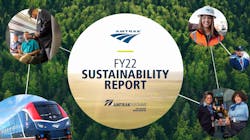Amtrak releases FY22 Sustainability Report
Amtrak’s fiscal year (FY) 2022 Sustainability Report details how Amtrak reduced diesel usage and air emissions, alongside increased purchases of carbon-free energy. The results support a company-wide climate commitment — incorporating environmental considerations into all business operations and coincides with a resurgence in passenger rail where Amtrak is bringing more trains to more places and expanding its network to connect more people across America.
“Sustainability sits at the heart of Amtrak’s value proposition: We aim to get you there reliably, safely and with a smaller impact on the environment,” said Amtrak CEO Stephen Gardner. “As we build a more modern Amtrak with federal funding from the landmark Infrastructure Investment and Jobs Act, we aim to lead a new era of sustainable passenger rail.”
Amtrak has cut greenhouse gas (GHG) emissions by more than 450,000 metric tons of carbon dioxide since 2010. That is the equivalent of powering more than 56,000 homes for one year. This reduction does not include additional GHG missions avoided each time a customer chooses Amtrak over driving or flying—a reduction of up to 83 percent or 72 percent, respectively.
Highlights from the report include:
- Net Zero by 2045: Amtrak pledged to achieve net-zero greenhouse gas emissions across the Amtrak network by 2045. The target focuses on expanding efforts across Amtrak’s entire carbon footprint to reduce environmental impacts while safely moving people.
- Renewable Diesel: Following a 2020/2021 pilot conducted by Capitol Corridor Joint Powers Authority and Caltrans — with support from Amtrak — locomotive manufacturers approved the use of renewable diesel on California’s state-supported passenger trains to begin in FY23. The change reduces reliance on fossil fuels and cuts lifecycle emissions produced by diesel locomotives.
- Fuel Reductions: In Chicago, Amtrak decreased fuel use — reducing locomotive idling by using automatic engine start-stop technology, shutting down engines when not in use and utilizing ground power electricity over diesel when possible. These strategies saved approximately 90,000 gallons of fuel.
- Lighting Efficiencies: Amtrak installed more than 3,000 new light fixtures, including 1,400 replacements of fluorescent or early-generation LED lights. The switch reduces Amtrak’s yearly GHG emissions output by roughly 500 metric tons.
- Expansion and Capital Investment: Amtrak invested $2.3 billion in capital projects, restored or expanded service along 11 routes, hired more than 3,700 new employees, saw ridership rebound by 89 percent over the previous year and announced the modernized Amtrak Airo trainsets.
